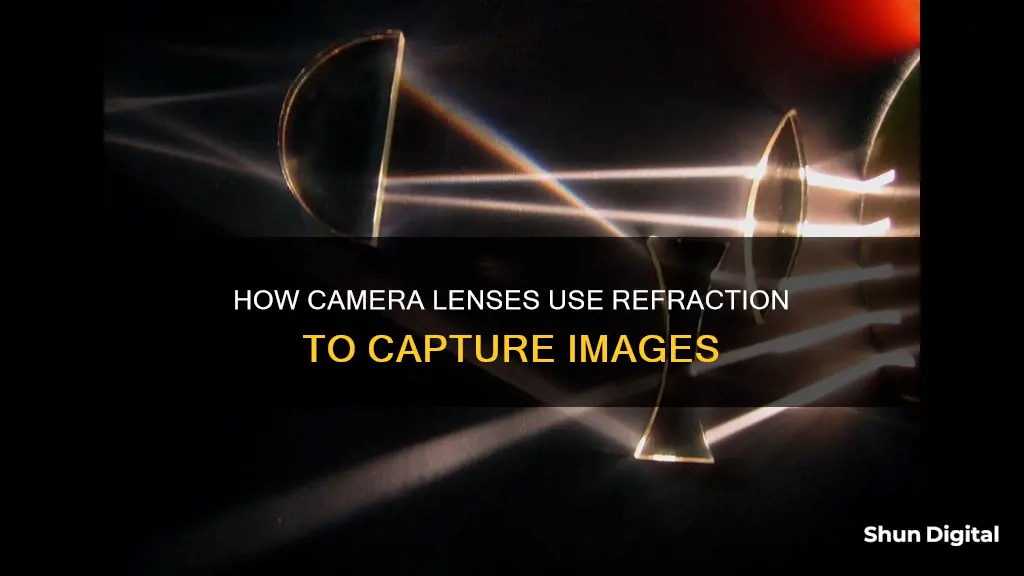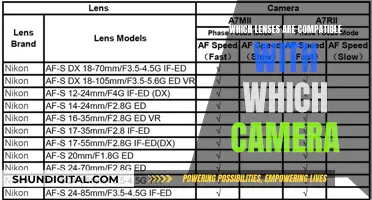
Camera lenses are an essential part of photography, acting as the eyes of the camera and influencing the quality, sharpness, and character of the images we capture. The intricate design and interaction of camera lenses with light is a fascinating area of exploration. One of the key aspects is the phenomenon of refraction, which occurs when light passes from one medium to another and changes direction at the boundary. This is crucial to how lenses work, as they rely on refraction to bend light and bring it to a focus, creating an image. The refractive index of the lens material determines how much the light is slowed down and bent, influencing the lens' focal length and the resulting image. Understanding these optical principles is key for photographers to make informed choices and improve their craft.
| Characteristics | Values |
|---|---|
| Function | Camera lenses use refraction to bend light and create images. |
| Design Factors | The refractive index of the material and the angle of incidence. |
| Image Quality | The quality, sharpness, and overall character of images depend on the intricate design of the lens and its interaction with light. |
| Focal Length | The distance from the lens to the focus point; it is measured in millimeters (mm) and varies depending on the lens thickness and curvature. |
What You'll Learn

Camera lenses refract light, creating images
Camera lenses are an essential part of photography, acting as the eyes of the camera and shaping how we capture the world. The intricate design and interaction of camera lenses with light play a critical role in determining the quality, sharpness, and overall character of the images we create.
To understand how camera lenses create images, we must explore the fundamentals of optics and the behaviour of light. Camera lenses refract light, which means they bend it. This refraction process is what allows the lens to focus light onto the camera sensor or film, creating a sharp image. The lens's curvature and refractive properties ensure that light rays passing through it converge to a single point, known as the focal point.
The refractive index of the glass used in camera lenses is crucial. It measures how much the light bends as it passes through the lens. Lenses with higher refractive indices can bend light more dramatically, affecting the image's final appearance. Different types of camera lenses have varying refractive indices, contributing to their distinct characteristics and uses.
Additionally, the focal length of a camera lens also influences how light is refracted. The focal length determines the angle at which light rays converge after passing through the lens. A longer focal length results in a narrower field of view, while a shorter focal length provides a wider field of view. This impacts the perspective and amount of the scene captured in the image.
By adjusting the refractive properties, focal length, and other characteristics of camera lenses, photographers can manipulate light to create diverse visual effects. This understanding of optics empowers photographers to make informed lens choices, ultimately enhancing the artistic and technical quality of their photographs.
Camera Lenses: Expensive, Fragile, and Worthy of Insurance Coverage
You may want to see also

The refractive index of the lens material affects the focal length
Camera lenses are an essential component of photography, as they act as the eyes of the camera and play a crucial role in determining the quality, sharpness, and overall character of the images we capture. The intricate design and complex interaction of camera lenses with light are based on the fundamentals of optics, which govern the behaviour of light.
The refractive index of an optical medium is a dimensionless number that indicates its light-bending ability. It determines how much the path of light bends or refracts when entering a material, as described by Snell's law of refraction. The refractive index is influenced by the wavelength of light and can vary across the electromagnetic spectrum, from X-rays to radio waves.
In the context of camera lenses, the refractive index of the lens material directly affects its focal length. A higher refractive index results in a shorter focal length, while a lower refractive index leads to a longer focal length. This relationship is described by the Lensmaker's formula:
> {\displaystyle {\frac {1}{f}}=(n-1)\left[{\frac {1}{R_{1}}}-{\frac {1}{R_{2}}}\right]\ ,}
Where f is the focal length of the lens, n is the refractive index, and R1 and R2 are the radii of curvature of the lens surfaces.
For example, lenses made of synthetic polymers like Lucite (refractive index of 1.47) have a slightly longer focal length compared to glass (refractive index of 1.51) due to their lower refractive index. On the other hand, a lens made of pure diamond (refractive index of 2.42) would have a significantly shorter focal length than glass or Lucite because of its higher refractive index.
The refractive index of the lens material also influences the bending of light as it passes through the lens. A higher refractive index means that the light beam will bend more as it travels from a high-density medium to a low-density medium. This phenomenon is crucial in understanding the behaviour of light within the lens and how it affects image formation.
Anti-Camera Lenses: Worth the Investment?
You may want to see also

The angle of incidence affects the degree of refraction
Camera lenses are an essential part of photography, acting as the eyes of the camera and influencing how we capture the world visually. The design of these lenses and their interaction with light are key to the quality and character of the images we create.
The angle of incidence is a fundamental concept in optics. It is the angle formed by a ray of light incident on a surface and the line perpendicular to that surface. This is also known as the normal. When light passes from one medium to another, such as from air to glass, the angle of incidence directly affects the degree of refraction.
As the angle of incidence increases, so does the angle of refraction. This relationship is described by Snell's Law, which states that the sine of the angle of incidence multiplied by the refractive index of the original medium is equal to the sine of the angle of refraction multiplied by the refractive index of the new medium. In simpler terms, this means that as the angle of incidence gets larger, the angle at which the light exits the lens (the angle of refraction) also gets larger.
This relationship is important in photography because it determines how light is bent as it passes through the camera lens. Different angles of incidence and refraction will result in different paths of light through the lens, affecting how the image is focused and ultimately captured by the camera's sensor or film.
By understanding and manipulating the angle of incidence, photographers can control the degree of refraction and, consequently, the characteristics of the final image. This knowledge is essential for making informed choices about lenses and capturing high-quality photographs.
Camera Lenses: Are Their Filters Universal?
You may want to see also

Lens shape and thickness impact the refraction of light
Camera lenses are indeed refractive, and the intricate design of these lenses, along with their complex interaction with light, plays a crucial role in photography. The lens shape and thickness impact the refraction of light, and thus the focal length of the lens.
The focal length of a lens tells us how far away from the lens a focused image is created, if the light rays approaching the lens are parallel. A lens with more "bending power" has a shorter focal length, as it alters the path of the light rays more effectively than a weaker lens. The lens maker's equation describes the relationship between lens thickness and focal length. The equation is:
\frac{1}{f}=(n-1)(\frac{1}{R_1}-\frac{1}{R_2}+\frac{(n-1)t}{nR_1R_2})
Where f is the focal length, n is the refractive index of the lens, R1 and R2 describe the curvature of the lens surfaces, and t stands for the thickness of the lens.
The thickness of the lens, t, generally results in a shorter focal length for thicker lenses. This is because thicker lenses have more "bending power" and can alter the path of light more effectively. The refractive index of the lens, n, also impacts the focal length. A higher refractive index means the lens bends light more, resulting in a shorter focal length.
The curvature of the lens, described by R1 and R2, also affects the focal length. A larger radius (shallower curve) will generally produce a larger focal length. Bi-convex lenses, which are symmetrical, have a focal length that depends on the curvature angle of their surfaces. Higher angles of curvature lead to shorter focal lengths as light waves are refracted at a greater angle with respect to the optical axis of the lens.
In summary, the lens shape and thickness impact the refraction of light by altering the focal length of the lens. Thicker lenses, lenses with a higher refractive index, and lenses with greater curvature generally result in shorter focal lengths.
Lenses Unlocked: Capturing Unique Perspectives and Effects
You may want to see also

Refraction is used to magnify or demagnify images
Camera lenses are an essential part of photography, acting as the eyes of the camera and determining how we capture the world visually. The design and interaction of camera lenses with light are crucial in producing the quality, sharpness, and overall character of the images.
Lenses have been used for over 2000 years to magnify or demagnify images. The phenomenon of refraction, which occurs when light travels from air into a different substance, such as glass or water, is key to this process. The speed of light is reduced, causing a change in direction at the boundary between the two substances. This change in direction results in the bending of light, with the angle of incidence (the angle of the incoming light) being larger than the angle of refraction when light enters a denser substance.
The shape of a camera lens plays a significant role in how it manipulates light. Convex lenses, with their thick central part curved outward, converge light rays to a focal point, resulting in the magnification of an image. Conversely, concave lenses, with their thin central part curved inward, spread light rays apart, leading to the demagnification of an image.
The focal length, or the distance between the lens and the focal point, is adjustable by combining convex and concave lenses. This adjustment allows for the magnification of small objects or the demagnification of distant objects, as seen in microscopes, cameras, and telescopes.
The intricate design of camera lenses, along with their interaction with light, is essential in shaping the visual output of images. By understanding the principles of refraction and the characteristics of different lenses, photographers can harness the power of camera lenses to elevate their craft.
How Camera Lenses Use Refraction to Capture Images
You may want to see also
Frequently asked questions
Refraction is the bending of light as it passes from one medium to another. This phenomenon occurs due to the difference in the speed of light in the two media, with the light slowing down as it passes through the second medium.
Refraction is essential to the functioning of camera lenses. By bending incoming light rays, camera lenses can focus all of the light into a single point, creating a clear and sharp image. The degree of refraction depends on the refractive index of the lens material.
There are two main types of camera lenses: convex and concave. A convex lens converges parallel light rays to a focal point using refraction. On the other hand, a concave lens spreads out these parallel light rays. By combining these two types of lenses, photographers can adjust the focal length and capture magnified images of small or distant objects.







